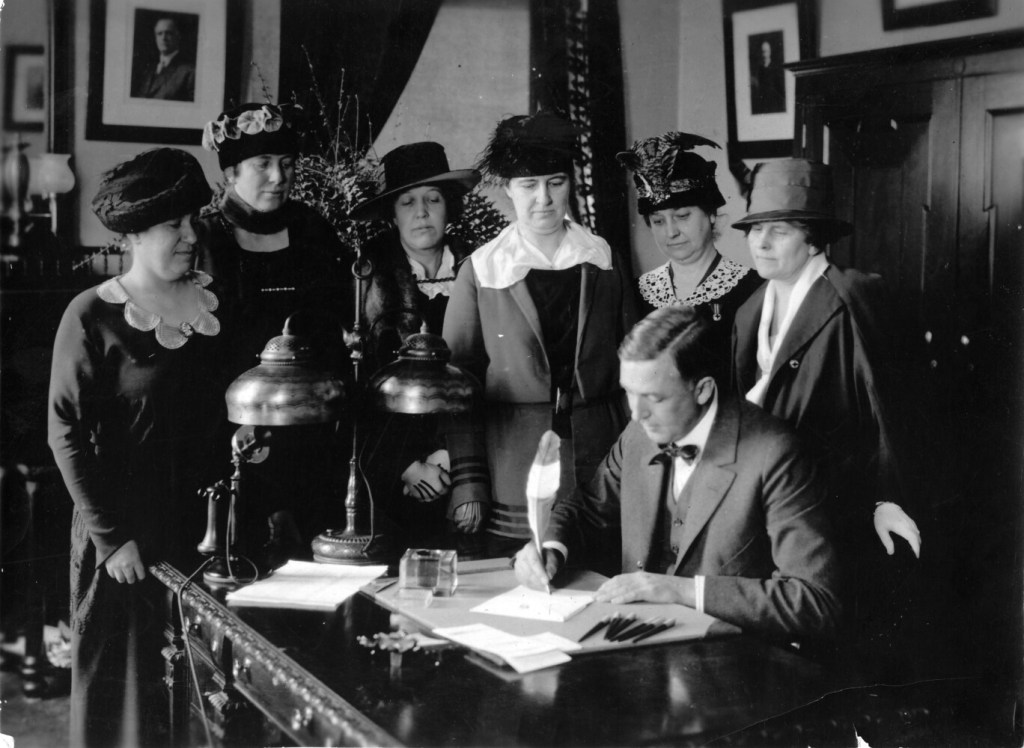Suffragist Camille Lessard Bissonnette was a 1904 immigrant to Maine who was born in Ste-Julie-de-Mégantic, Quebec, in 1883, and immigrated to Maine from Laurierville, Quebec. Camille was a protofeminist in the early 1900s. She became a schoolteacher at age 16 while living in Quebec and when she immigrated to Lewiston, she began working in the Continental Mill. Two years later, she also joined the staff of Le Messager, Lewiston’s French-language newspaper.
Camille was a correspondent of the paper until 1938. In 1910, Camille, as a journalist, wrote her support of the suffrage movement, two years before the conversation began in Canada.
As a French heritage woman, immigrated from Canada, her views were unique and daring given the inherent reluctance on the part of the French-speaking cultures, worldwide, to grant women the vote – women in Quebec were granted the vote in 1940 and women in France, 1945. In order to understand Camille’s suffrage situation, it is necessary to be aware of her bicultural, bilingual, bi-border conversation with the women in French Canada as well as her commentary meant for the immigrant working women in Lewiston for whom she wrote her columns in Le Messager.
Camille, as a woman of the French heritage, language, culture and ethnicity, struggled against the thinking and beliefs of the larger dominant group and also against many of her own, women and men, in the culture. Her struggle to voice her opinion of pro-the vote for women existed in soundproof vacuum of the deafness to cultural diversity.
Camille expressed her views on the reasons why she believed women should be granted the right to vote despite the deterrents from the culture, the clergy and journalists. The arguments against giving women the right to vote were centered on their place in the home and their role as guardians of the French-Canadian race.
In Canada, the Constitutional Act of 1791 had granted certain landowners qualified voter status with no distinction to gender. Women of Lower Canada, Quebec, interpreted this oversight as permission to vote and did so up until 1849, when women’s right to vote was taken away by Quebec men, who had taken notice of the women’s rights convention in Seneca Falls, New York, the year before. From 1912 to 1922, Canada’s suffrage movement era occurred with the vote granted nationally in 1918. After women obtained the right to vote in federal elections in 1919, the struggle continued for the same right to vote on a provincial level.
This is the cultural mindset Camille was surrounded by when she took a stand, publicly, voicing her opinion pro the vote for women in a debate and through her writings as early as 1910. She was a regular correspondent for Le Messager and her talk was printed on Page 2 of the newspaper, simply titled, “Le Suffrage des Femmes,” signed with her pen name, Liane, while M. Poulin’s address appeared three days later on Page 1 of Le Messager, titled, “Villante réplique au discours de Liane, advocate du suffrage des femmes” (“Villante replies to the speech of Liane, advocate of women’s suffrage”). Her message is reduced by the cultural press and men of the culture.
Camille debated with her readership in Maine and in Canada about her desire that women be granted the vote. The larger picture for the French heritage woman had to include the conversation across the borders. Camille was seen as a force that influenced the women in Quebec in regard to the vote. Using her journalistic platform, she expressed her opinions to both the women in the U.S. — Maine — and also to the women in Quebec, Canada, as to why women should be able to vote. This was in 1911. In 1912, English Canada began their collective movement to work toward gaining the vote. 1922 was the beginning of the movement for suffrage in Quebec.
Camille was the lone voice speaking to the suffrage action in the Maine French heritage women’s public space.
Recognition of Camille’s efforts in voicing her opinion is important to understand that there was an immigrant woman of French heritage in Maine who was pro-the vote for women and that she was vocal about those beliefs in an atmosphere that was hostile to such views.
The prejudices against the French heritage culture and people posit for women a double discrimination based on gender and ethnicity.
Even if Camille’s voice lacked, or lacks amplification, she presents a very important aspect of the presence of the French heritage women in the state of Maine that is a reality today.
Send questions/comments to the editors.



Comments are no longer available on this story